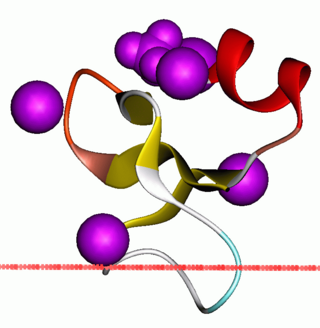
Beta defensins are a family of vertebrate defensins. The beta defensins are antimicrobial peptides implicated in the resistance of epithelial surfaces to microbial colonization.

Defensin, alpha 1 also known as human alpha defensin 1, human neutrophil peptide 1 (HNP-1) or neutrophil defensin 1 is a human protein that is encoded by the DEFA1 gene. Human alpha defensin 1 belongs to the alpha defensin family of antimicrobial peptides.

Trefoil factor 3 is a protein that in humans is encoded by the TFF3 gene.

Histone H2B type 1-C/E/F/G/I is a protein that in humans is encoded by the HIST1H2BG gene.

Histone H2B type 1-K is a protein that in humans is encoded by the HIST1H2BK gene.

Beta-defensin 103 is a protein that in humans is encoded by the DEFB103A gene.

Homeobox protein Hox-D11 is a protein that in humans is encoded by the HOXD11 gene.

Protocadherin beta-10 is a protein that in humans is encoded by the PCDHB10 gene.

Defensin, alpha 5 (DEFA5) also known as human alpha defensin 5 (HD5) is a protein that in humans is encoded by the DEFA5 gene. DEFA5 is expressed in the Paneth cells of the ileum.

Beta-defensin 104 is a protein that in humans is encoded by the DEFB104A gene.

Zinc finger protein 33B is a protein that in humans is encoded by the ZNF33B gene.

Protein DGCR6 is a protein that in humans is encoded by the DGCR6 gene.

Beta-defensin 127 is a protein that in humans is encoded by the DEFB127 gene.

Beta-defensin 105 is a protein that is encoded by the DEFB105A gene in humans.

Beta-defensin 119 is a protein that in humans is encoded by the DEFB119 gene.

Beta-defensin 129 is a protein that in humans is encoded by the DEFB129 gene.

Dipeptidase 3 (DPEP3) is a protein that in humans is encoded by the DPEP3 gene.

Defensin, alpha 6 (DEFA6) also known as human alpha defensin 6 (HD6) is a human protein that is encoded by the DEFA6 gene. DEFA6 is expressed in the Paneth cells of the ileum.

Defensin, alpha 3 (DEFA3) also known as human alpha defensin 3, human neutrophil peptide 3 (HNP-3) or neutrophil defensin 3 is a human protein that is encoded by the DEFA3 gene. Human alpha defensin 3 belongs to the alpha defensin family of antimicrobial peptides.

8p23.1 duplication syndrome is a rare genetic disorder caused by a duplication of a region from human chromosome 8. This duplication syndrome has an estimated prevalence of 1 in 64,000 births and is the reciprocal of the 8p23.1 deletion syndrome. The 8p23.1 duplication is associated with a variable phenotype including one or more of speech delay, developmental delay, mild dysmorphism, with prominent forehead and arched eyebrows, and congenital heart disease (CHD).


















